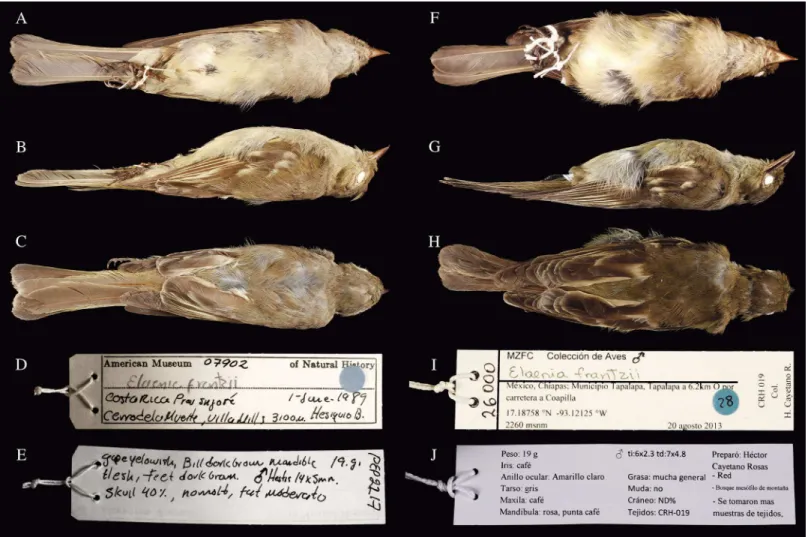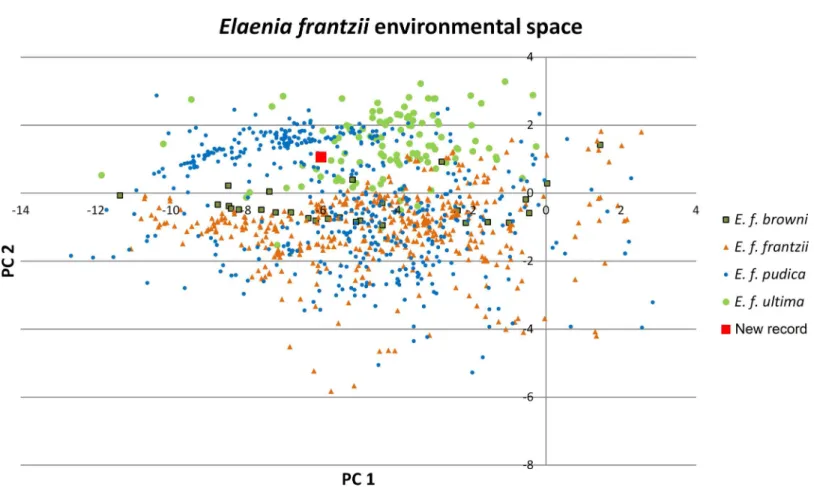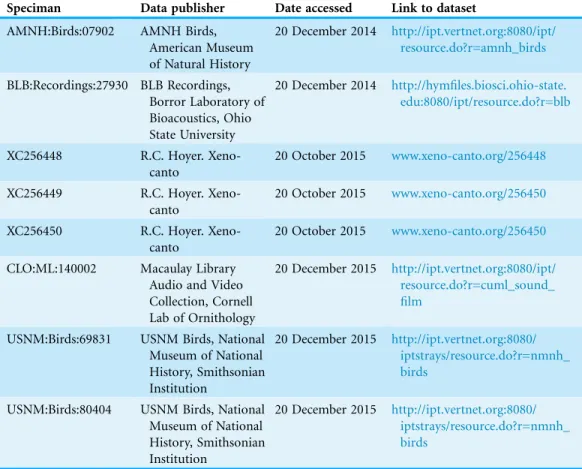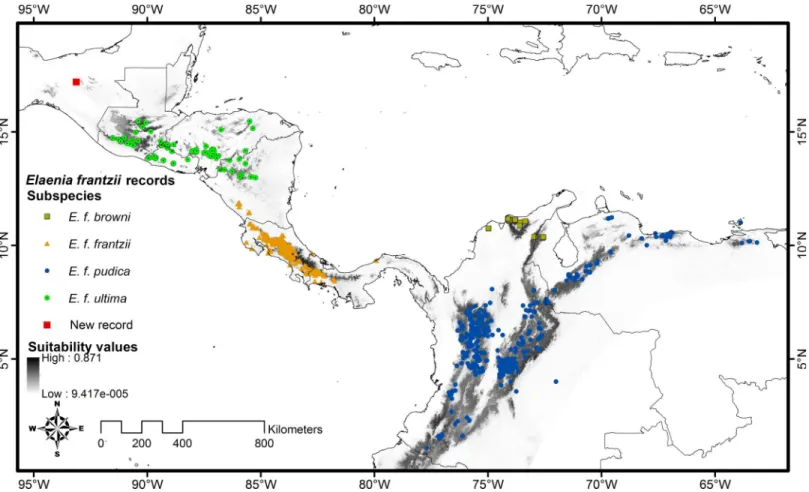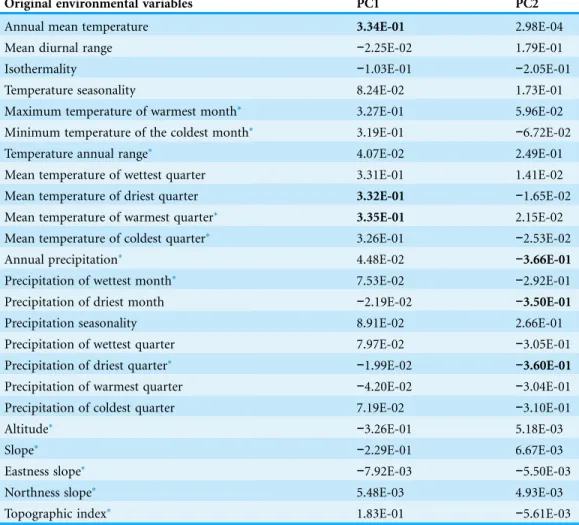Phylogenetic and morphologic evidence
confirm the presence of a new montane
cloud forest associated bird species in
Mexico, the Mountain Elaenia (
Elaenia
frantzii
; Aves: Passeriformes: Tyrannidae)
Zachary R. Hanna1,2,3, Marco F. Ortiz-Ramı´rez4,5, Ce´sar A. Rı´os-Mun˜oz4,6, He´ctor Cayetano-Rosas4,5, Rauri C. K. Bowie1,2and Adolfo G. Navarro-Sigu¨enza4
1Museum of Vertebrate Zoology, University of California, Berkeley, Berkeley, California, United States of America
2Department of Integrative Biology, University of California, Berkeley, Berkeley, California, United States of America
3Ornithology & Mammalogy, California Academy of Sciences, San Francisco, California, United States of America
4Museo de Zoologı´a, Facultad de Ciencias, Universidad Nacional Auto´noma de Me´xico, Me´xico, Distrito Federal, Me´xico
5Posgrado en Ciencias Biolo´gicas, Universidad Nacional Auto´noma de Me´xico, Me´xico, Distrito Federal, Me´xico
6Unidad de Investigacio´n en Medicina Experimental, Facultad de Medicina, Universidad Nacional Auto´noma de Me´xico, Me´xico, Distrito Federal, Me´xico
ABSTRACT
Here we provide evidence to support an extension of the recognized distributional range of the Mountain Elaenia (Elaenia frantzii) to include southern Mexico. We collected two specimens in breeding condition in northwestern Sierra Norte de Chiapas, Mexico. Morphologic and genetic evidence support their identity as
Elaenia frantzii. We compared environmental parameters of records across the entire geographic range of the species to those at the northern Chiapas survey site and found no climatic differences among localities.
Subjects Biodiversity, Biogeography, Genetics, Taxonomy, Zoology
Keywords Ornithology, Passeriformes, New record, Chiapas, Me´xico, Central America, Niche modeling, Elaenia frantzii, Suboscine
INTRODUCTION
The Mountain Elaenia (Elaenia frantzii) is a small New World flycatcher that breeds in the high elevation forests of Central America and northern South America and is known to move seasonally to lower elevations (Stiles & Skutch, 1989). Its distribution has previously been reported to include isolated populations extending from Colombia and Venezuela as far north as north-central Guatemala (Land, 1970;Howell & Webb, 1995;Eisermann & Avendan˜o, 2007), but it has not been documented in Mexico (Peterson & Chalif, 1973; Hosner, 2004). Its habitat consists of a variety of open humid to semi-humid forest types, including forest edges, secondary growth, and farmland, in an altitudinal range of
Submitted10 November 2015 Accepted23 December 2015 Published1 February 2016 Corresponding author
Zachary R. Hanna, zachanna@berkeley.edu
Academic editor
Michael Wink
Additional Information and Declarations can be found on page 11
DOI10.7717/peerj.1598 Copyright
2016 Hanna et al.
Distributed under
750–3600 m. A continuum of fragmented cloud forest extends from the east of the Isthmus of Tehuantepec to the Nicaraguan depression (Ramı´rez-Barahona & Eguiarte, 2014), providing potential habitat for this bird in southern Mexico.
We analyzed the morphological and molecular characteristics of two specimens collected in Chiapas, Mexico, during August 2013 and compared them with the associated data from museum specimens of otherE. frantzii. We additionally investigated environmental parameters from the previously known distribution ofE. frantziiand compared them with those present in southern Mexico to assess the likelihood that suitable conditions exist in southern Mexico to support a resident population of this species.
METHODS
Taxon morphological description
Elaenia frantziiis a small tyrant flycatcher with a rounded head lacking a coronal patch. It has dark brown irides and narrow, pale-lemon eye-rings. Its bill is black with a pale, flesh-colored base of the lower mandible and a dusky culmen and tip. The head and upperparts are brownish olive, the throat and chest are grayish olive, and the belly and undertail coverts are pale-lemon. The wing is dusky with conspicuous yellowish wing-bars. The edges of the remiges are yellowish and the tertial edgings are white. The legs are blackish. Males and females have similar external morphology (Howell & Webb, 1995;Hosner, 2004).
Elaenia frantziihas a patchy distribution throughout the mountain systems of Central and South America. It inhabits open humid to semi-humid forest, forest edges, secondary growth, and farmland areas where scattered bushes and trees are present. Based on geographic distribution and subtle differences in plumage color and body size, four
E. frantziisubspecies are recognized (Hosner, 2004).
The nominate subspecies,E. f. frantziiLawrence, 1867, is found in Nicaragua, Costa Rica, and Panama (Hosner, 2004).Elaenia frantzii pudicaSclater, 1871is overall smaller, darker above, and paler below than the nominate subspecies and inhabits the Andes mountains of northern Colombia and Venezuela (Hosner, 2004).Elaenia frantzii browni
Bangs, 1898is restricted to the Sierra Nevada de Santa Marta of northern Colombia and the Sierra de Perija´ of northwestern Venezuela and is yet smaller and with paler upperparts thanE. frantzii pudica(Hosner, 2004).Elaenia frantzii ultimaGriscom, 1935is a subspecies darker than the nominate inhabiting Guatemala, Honduras and El Salvador and is the most proximately distributed subspecies to southern Mexico (Hosner, 2004). SeeFig. 1for a map of the distributions of the subspecies.
Elaenia frantziican be distinguished from the Yellow-bellied Elaenia (E. flavogaster), a Mexican resident species, by the lack of a white coronal patch, more greenish coloration of the upperparts and less extended yellow in the underparts. Although the coloration is similar to some members of the genusEmpidonax,E. frantziidiffers from them in its narrow eye-ring and the relative proportions of the body, head and bill.
Study area
Universidad Nacional Auto´noma de Me´xico team formed to survey the bird, mammal, and herpetological diversity at montane sites in southern Mexico, we traveled to a tract of cloud forest 6.2 km W (by road) from the center of Tapalapa on the road to Coapilla, Municipio Tapalapa, Chiapas, Mexico in August 2013. We sampled the avifauna of the site using mist-nets from 20–24 August 2013 under field permit FAUT-0169 granted by the Mexican government agency Secretarı´a de Medio Ambiente y Recursos Naturales and with animal ethical approval R317 granted by the UC Berkeley Institutional Animal Care and Use Committee. The mist-nets were 6–12 m long, 2.5 m high, and were made of 16 mm16 mm mesh. We preserved a portion of the captured individuals as voucher
specimens and deposited them in ornithological research collections at the Museum of Vertebrate Zoology (MVZ) and Museo de Zoologı´a “Alfonso L. Herrera” (MZFC). We collected tissue samples and assessed the breeding condition of each voucher specimen by measuring gonads and recording any evidence of a brood patch or cloacal protuberance. We also recorded data on molt, fat, skull ossification, and parasite load. After returning
from the field, we confirmed the species status of the collected specimens by comparing their preserved external morphologies with individuals deposited in the MZFC.
Bibliographic search
We conducted all searches described below on 20 December 2014. We performed a literature search for published observations ofE. frantziiin Mexico. We additionally searched for records of E. frantziiin VertNet (http://www.vertnet.org), a web-based biodiversity data aggregator. We also searched eBird (Sullivan et al., 2009;
http://www.ebird.org), an online checklist program, which archives lists of bird sightings submitted by professional and amateur birdwatchers, forE. frantziisightings most proximate to Mexico. As an assessment of whether a lack of documentation of this species in Chiapas, Mexico might be a result of low sampling effort or due to this species having recently expanded its range into Chiapas, we performed a search in VertNet (http://www. vertnet.org) on 20 December 2014 with Record Type = “Any type” and using the following Darwin Core terms: Class = “Aves,” Country = “Mexico,” and StateProvince = “Chiapas.”
Laboratory protocol
We gathered genetic evidence to support our morphology-based identifications by sequencing 1041 bp of the mitochondrial locus Nicotinamide Adenine Dinucleotide Dehydrogenase Subunit 2 (ND2). We first extracted genomic DNA from∼25 mg of liver
tissue using a DNeasy Blood & Tissue Kit (Qiagen, Hilden, Germany). We then amplified the mitochondrial locusND2using the primers L5204 and H6312 (Cicero & Johnson, 2001). Polymerase chain reaction (PCR) conditions included an initial denaturation at 94
C for 3 min; then 30 cycles at 94C for 30 s, 54C for 30 s, and 72C for 1 min 30 s; and a
final extension at 72C for 10 min. We sequenced PCR products in both forward and
reverse directions using BigDye terminator chemistry (Applied Biosystems, Foster City, CA, USA) on an ABI 3730 automated sequencer (Applied Biosystems, Foster City, CA, USA). We edited and constructed consensus sequences using Geneious version 7.1.7 (Kearse et al., 2012;http://www.geneious.com).
Maximum likelihood tree
We retrieved completeND2 gene sequences for 20 additional individuals representing 10 tyrannid taxa from GenBank (accession numbers appended to the end of taxon names in Fig. 2). We aligned sequences using MUSCLE (Edgar, 2004) and constructed a maximum likelihood tree using RAxML version 8.1.20 (Stamatakis, 2014). We used the GTRGAMMA model, searched for the tree with the highest likelihood, and estimated node support using 1000 bootstrap pseudoreplicates.
Environmental characterization and species distribution model
which is the expanse that includes all vouchered records available for the species. We used a set of 19 bioclimatic variables obtained from the WorldClim project
(Hijmans et al., 2005;http://www.worldclim.org) and five topographic variables; obtained from the Hydro1k project (https://lta.cr.usgs.gov/HYDRO1K), which summed to 24 variables to characterize the environment of the potential distribution of
E. frantzii(Table 1).
We summarized the ecological variation across the distribution ofE. frantziiby performing a principal component analysis (PCA) on the values of the 24 ecological variables from the sites of georeferencedE. frantziioccurrence records using the package ENMGadgets (Barve & Barve, 2014) in R version 3.2.2 (R Core Team, 2015). This reduced the multidimensionality of the 24 ecological variables. We then associated all of the records ofE. frantziiwith the PCA output, obtained PCA values for each locality, and plotted PC1 and PC2 of each E. frantziirecord.
We employed Maxent 3.3.3k (Phillips, Anderson & Schapire, 2006) to model the distribution ofE. frantziiand assess the suitability of the new Chiapas location as compared with the sites of otherE. frantziioccurrences. We used the package raster (Hijmans, 2015) and the implementation of the Pearson correlation index in R version
3.2.2 (R Core Team, 2015) to select a subset of 13 of the 24 bioclimatic and topographic variables with correlation values below 0.85 (Table 1) to avoid over parameterization of the model (Elith et al., 2006;Elith & Leathwick, 2007). We used the 13 environmental variable subset and all of the georeferencedE. frantziioccurrence records in Maxent 3.3.3k (Phillips, Anderson & Schapire, 2006) to generate ten model replicates (using the
subsample replicated run type) using 30% of the sample records to test the variability produced by a random selection of the training data (random seed). We obtained suitability values from the Maxent model and mapped them along with all of the
E. frantziioccurrence records using ArcMap 10.0 (ESRI).
RESULTS
Bibliographic search
We found no published observations ofE. frantziiin Mexico. The northernmost record of this species in VertNet is a 1.41 s audio recording of a call from northeast Utah, United States of America made in May 1999 (BLB:Recordings:27930:Table 1). This record is likely a misidentification or, if not, it documents a vagrant and does not indicate a breeding population as there are no other records ofE. frantziiwithin 3000 km
Table 1 Elaenia frantziispecimen data.We here provide further information regarding the datasets that archive theElaenia frantziispecimens to which we refer throughout the manuscripit.
Speciman Data publisher Date accessed Link to dataset
AMNH:Birds:07902 AMNH Birds, American Museum of Natural History
20 December 2014 http://ipt.vertnet.org:8080/ipt/ resource.do?r=amnh_birds
BLB:Recordings:27930 BLB Recordings, Borror Laboratory of Bioacoustics, Ohio State University
20 December 2014 http://hymfiles.biosci.ohio-state. edu:8080/ipt/resource.do?r=blb
XC256448 R.C. Hoyer. Xeno-canto
20 October 2015 www.xeno-canto.org/256448
XC256449 R.C. Hoyer. Xeno-canto
20 October 2015 www.xeno-canto.org/256450
XC256450 R.C. Hoyer. Xeno-canto
20 October 2015 www.xeno-canto.org/256450
CLO:ML:140002 Macaulay Library Audio and Video Collection, Cornell Lab of Ornithology
20 December 2015 http://ipt.vertnet.org:8080/ipt/ resource.do?r=cuml_sound_ film
USNM:Birds:69831 USNM Birds, National Museum of National History, Smithsonian Institution
20 December 2015 http://ipt.vertnet.org:8080/ iptstrays/resource.do?r=nmnh_ birds
USNM:Birds:80404 USNM Birds, National Museum of National History, Smithsonian Institution
of this location. The records ofE. frantziiclosest to Mexico along the land axis of Central America are in southwestern Guatemala (CLO:ML:140002, USNM:Birds:69831, USNM:Birds:80404:Table 1). The sightings closest to Mexico publicly visible in eBird (Sullivan et al., 2009;http://www.ebird.org) as of 20 December 2014 were made in July 2001 at 14.7173609N and 91.5309191W, WGS84, Santa Marı´a de Jesu´s,
Departamento Quetzaltenango, Guatemala (Berry, 2001) and in February 2013 at 15.4769771N and 90.3913987W, WGS84, Coba´n, Departamento Alta Verapaz,
Guatemala (Cahill, 2013).Figure 3includes these records. Our class Aves-based VertNet search indicated that there have been avian records from montane regions in Chiapas from every decade spanning the years 1880–2009, butE. frantziihas never been detected in this region.
Morphological identification
We surveyed for a total of 283.39 12-m net hours and captured two individuals, which we gave a preliminary designation ofE. frantziibased on plumage and morphology and assigned to the collector numbers CRH019 and ZRH814. We captured CRH019 on
20 August 2013. It did not display any evidence of molt and was a male in breeding condition with a right testis of 74.8 mm. We captured ZRH814 on 23 August 2013.
ZRH814 was a female in breeding condition with an 84 mm ovary containing
two collapsed follicles. It had extensive fat layers, a fully ossified skull, and no evidence of molt.
We deposited a round skin voucher specimen and tissue sample of CRH019 in MZFC as MZFC:26000. We archived a tissue sample of CRH019 in MVZ as MVZ: Birds:188004. We deposited a round skin voucher specimen and tissue sample of ZRH814 in MVZ as MVZ:Birds:188003. We archived a tissue sample of ZRH814 in MZFC as ZRH814.
We confirmed the identity of the Chiapas specimens through comparison with
E. frantziimuseum skins. Compared with theE. f. frantziispecimen (AMNH:Birds:07902:
Table 1) collected in Costa Rica, the newly collected specimens are darker in the upperparts, tail, and wings. The chest and flanks are more olive-colored and darker overall. The edges of the remiges are narrower and contain less yellow. The bill is wider at the distal edge of the nostrils (4 mm in our specimen vs. 3 mm in the Costa Rica specimen) (Fig. 3). These differences are in agreement with the description of the subspecies ultimacompared tofrantzii(Hosner, 2004).
Molecular identification
We obtained the completeND2gene sequence, 1041 bp, from specimens MZFC:26000 and MVZ:Birds:188003, which shared the same ND2haplotype. We deposited newly generated sequences in GenBank (accession numbersKU312259–KU312260). The maximum likelihood tree grouped the ChiapasE. frantzii ND2sequence with sequences of
E. frantziifrom El Salvador and Panama (GenBank accession numbersEU311059and
EU311049, respectively) with 100% bootstrap support (Fig. 4).
Environmental characterization and species distribution model
The first two principal components of the 24 bioclimatic and topographic variables included 63.24% of the cumulative ecological variance for the species. The variables which have higher eigenvectors for component 1 are mainly associated with temperature variables whereas those for component 2 are primarily associated with precipitation (Table 2). Values of the environmental variables at the new Chiapas locality fall within the variation of those variables at E. frantziioccurrence sites in populations from Central America and South America (Fig. 4).
We chose the median Maxent model of the ten replicates we generated in order to account for the variation produced by the random selection of sample record seeds in each replicate. The suitability value at the site of the new record ofE. frantziiin Chiapas is 0.24. The highest suitability value in our model was 0.87. The sites of 94% of the E. frantzii
DISCUSSION
Morphological and molecular evidence confirm the presence of a breeding population of
E. frantziiin Mexico. These records warrant an extension of the range ofE. frantziito include the state of Chiapas, Mexico. The closest locality of a publicly available, georeferenced voucher (an audio voucher in this instance) to our new records is 360 km away (by air) in Guatemala (140002, Macaulay Library Audio and Video Collection, Cornell Lab of Ornithology). Our collection site is 190 km from the Guatemalan border in the northwestern Sierra Norte de Chiapas at the northern
limit of Nuclear Central America (NCA), the area between the Isthmus of Tehuantepec and the Nicaraguan depression (Schuchert, 1935). It is not surprising thatE. frantzii’s range could include the extreme northern portion of NCA as its previously known range includes much of the rest of NCA, across which environmental conditions are largely similar (Ramı´rez-Barahona & Eguiarte, 2014). Our ecological niche analyses indicate that climatic conditions whereE. frantziiis found in Central and South America are present in Chiapas, Mexico. This distributional pattern of inhabiting cloud forests from Chiapas south through NCA is exhibited by other species of montane birds, such asChlorospingus ophthalmicus, Catharus frantzii, andAtlapetes albinucha(Howell & Webb, 1995), which we
also recorded at this locality. After we completed our literature searchers and began to prepare this manuscript, a group of bird watchers visited several sites in the vicinity of our survey site near Tapalapa, Chiapas, Me´xico on 7–13 July 2015. The birders sighted multiple
Elaenia frantzii(Martinez, 2015;Hoyer, 2015) and made several recordings of their calls (XC256448, XC256449, XC256450:Table 1). These detections indicate that the population that we surveyed appears to be persisting.
It is remarkable that this species was previously unknown to Chiapas, despite sampling having been conducted at montane sites in the area over the past century. It is possible that this species has been misidentified in past surveys and collections due to its resemblance to other flycatcher species in the genusEmpidonax, whose distributions are known to include Chiapas. Although biological and geological evidence supports the idea of a barrier located at the Motagua-Polochic-Jocota´n fault system in central Guatemala with phylogenetic implications for the biota (Morrone, 2001;
Table 2 Environmental variables and their eigenvectors from the principal component analysis (PCA). PC1 and PC2 refer to the first two principal components of the PCA. We have highlighted the three highest loading values for each principal component in bold. Variables with a trailing asterisk.
Original environmental variables PC1 PC2
Annual mean temperature 3.34E-01 2.98E-04
Mean diurnal range −2.25E-02 1.79E-01
Isothermality −1.03E-01 −2.05E-01
Temperature seasonality 8.24E-02 1.73E-01
Maximum temperature of warmest month* 3.27E-01 5.96E-02
Minimum temperature of the coldest month* 3.19E-01
−6.72E-02
Temperature annual range* 4.07E-02 2.49E-01
Mean temperature of wettest quarter 3.31E-01 1.41E-02
Mean temperature of driest quarter 3.32E-01 −1.65E-02
Mean temperature of warmest quarter* 3.35E-01 2.15E-02
Mean temperature of coldest quarter* 3.26E-01
−2.53E-02
Annual precipitation* 4.48E-02 −3.66E-01
Precipitation of wettest month* 7.53E-02
−2.92E-01
Precipitation of driest month −2.19E-02 −3.50E-01
Precipitation seasonality 8.91E-02 2.66E-01
Precipitation of wettest quarter 7.97E-02 −3.05E-01
Precipitation of driest quarter*
−1.99E-02 −3.60E-01
Precipitation of warmest quarter −4.20E-02 −3.04E-01
Precipitation of coldest quarter 7.19E-02 −3.10E-01
Altitude*
−3.26E-01 5.18E-03
Slope*
−2.29E-01 6.67E-03
Eastness slope*
−7.92E-03 −5.50E-03
Northness slope* 5.48E-03 4.93E-03
Topographic index* 1.83E-01
−5.61E-03
Note:
Gutie´rrez-Garcı´a & Va´zquez-Domı´nguez, 2013;Rı´os-Mun˜oz, 2013), our limited sampling cannot confirm the existence of a differentiated population in Mexico. We recommend further studies to assess population size and conservation status for this species in Mexico.
ACKNOWLEDGEMENTS
We thank the institutions that provided information to the Global Biodiversity Information Facility. Thank you to the Secretarı´a de Medio Ambiente y Recursos Naturales for field work authorizations. We are grateful to Sean Rovito for excellent logistical skills that made our field expedition such a success. Thank you to Ana Isabel Bieler Antolı´n and the Microcine Lab, Facultad de Ciencias, UNAM for help with the photographs of specimens. Thank you to Michael L. P. Retter for providing feedback on our manuscript and directing us to information concerning the more recent sightings of Elaenia frantziiin Chiapas. Thank you to Willem-Pier Vellinga for directing us to the Xeno-canto recordings from Chiapas. We generated genetic data at the Evolutionary Genetics Laboratory, Museum of Vertebrate Zoology.
ADDITIONAL INFORMATION AND DECLARATIONS
Funding
The National Science Foundation funded field and laboratory work under grant no. DEB 1026393 to R.C.K.B. This material is based upon work supported by the National Science Foundation Graduate Research Fellowship under grant no. DGE 1106400 to Z.R.H. Any opinion, findings, and conclusions or recommendations expressed in this material are those of the authors and do not necessarily reflect the views of the National Science Foundation. Any use of trade, product, or firm names in this publication is for descriptive purposes only and does not imply endorsement by the U.S. Government. The funders had no role in study design, data collection and analysis, decision to publish, or preparation of the manuscript.
Grant Disclosures
The following grant information was disclosed by the authors: National Science Foundation: DEB 1026393.
National Science Foundation Graduate Research Fellowship: DGE 1106400.
Competing Interests
The authors declare that they have no competing interests.
Author Contributions
Zachary R. Hanna conceived and designed the experiments, performed the
Marco F. Ortiz-Ramı´rez conceived and designed the experiments, performed the
experiments, analyzed the data, wrote the paper, prepared figures and/or tables, reviewed drafts of the paper.
Ce´sar A. Rı´os-Mun˜oz conceived and designed the experiments, performed the
experiments, analyzed the data, wrote the paper, prepared figures and/or tables, reviewed drafts of the paper.
He´ctor Cayetano-Rosas conceived and designed the experiments, performed the
experiments, analyzed the data, wrote the paper, prepared figures and/or tables, reviewed drafts of the paper.
Rauri C. K. Bowie conceived and designed the experiments, contributed reagents/
materials/analysis tools, reviewed drafts of the paper.
Adolfo G. Navarro-Sigu¨enza conceived and designed the experiments, contributed
reagents/materials/analysis tools, reviewed drafts of the paper.
Animal Ethics
The following information was supplied relating to ethical approvals (i.e., approving body and any reference numbers):
UC Berkeley Institutional Animal Care and Use Committee approval number R317.
Field Study Permissions
The following information was supplied relating to field study approvals (i.e., approving body and any reference numbers):
Secretarı´a de Medio Ambiente y Recursos Naturales permit number FAUT-0169.
DNA Deposition
The following information was supplied regarding the deposition of DNA sequences: GenBank accession numbersKU312259–KU312260.
Data Deposition
The following information was supplied regarding data availability:
Specimen CRH019 round skin and tissue sample deposited as MZFC:26000, Museo de Zoologı´a “Alfonso L. Herrera,” Facultad de Ciencias, Universidad Nacional Auto´noma de Me´xico.
Specimen CRH019 tissue sample deposited as MVZ:Birds:188004, Museum of Vertebrate Zoology, University of California, Berkeley.
Specimen ZRH814 round skin and tissue sample deposited as MVZ:Birds:188003, Museum of Vertebrate Zoology, University of California, Berkeley.
Specimen ZRH814 tissue sample deposited as ZRH814, Museo de Zoologı´a “Alfonso L. Herrera,” Facultad de Ciencias, Universidad Nacional Auto´noma de Me´xico.
Supplemental Information
REFERENCES
Bangs O. 1898.On some birds from Pueblo Viejo, Colombia.Proceedings of the Biological Society of Washington12:158.
Barve N, Barve V. 2014.ENMGadgets: Tools for Pre and Post Processing in ENM workflow. R package version 0.0.11,Available athttps://github.com/narayanibarve/ENMGadgets. Berry J. 2001.eBird Checklist:http://ebird.org/ebird/camerica/view/checklist?subID=S5135946.
eBird: An online database of bird distribution and abundance. Ithaca: eBird.Available athttp:// www.ebird.org(accessed on 20 December 2014).
Cahill J. 2013.eBird Checklist:http://ebird.org/ebird/view/checklist?subID=S13309447. eBird: An online database of bird distribution and abundance. Ithaca: eBird.Available athttp://www. ebird.org(accessed on 20 December 2014).
Cicero C, Johnson NK. 2001.Higher-level phylogeny of New World Vireos (Aves: Vireonidae) based on sequences of multiple mitochondrial DNA genes.Molecular Phylogenetics and Evolution20:27–40.
Edgar RC. 2004.MUSCLE: multiple sequence alignment with high accuracy and high throughput.
Nucleic Acids Research32:1792–1797.
Eisermann K, Avendan˜o C. 2007.Lista comentada de las aves de Guatemala: Annotated checklist of the birds of Guatemala. Barcelona: Lynx Edicions.
Elith J, Graham CH, Anderson RP, Dudı´k M, Ferrier S, Guisan A, Hijmans RJ, Huettmann F, Leathwick JR, Lehmann A, Li J, Lohmann LG, Loiselle BA, Manion G, Moritz C,
Nakamura M, Nakazawa Y, Overton JMcCM, Townsend Peterson A, Phillips SJ, Richardson K, Scachetti-Pereira R, Schapire RE, Sobero´n J, Williams S, Wisz MS, Zimmermann NE. 2006.Novel methods improve prediction of species’ distributions from occurrence data.Ecography29:129–151.
Elith J, Leathwick J. 2007.Predicting species distributions from museum and herbarium records using multiresponse models fitted with multivariate adaptive regression splines.Diversity and Distributions13:265–275.
Griscom L. 1935.Critical notes on Central American Birds in the British Museum.Ibis
77:550–551.
Gutie´rrez-Garcı´a TA, Va´zquez-Domı´nguez E. 2013.Consensus between genes and stones in the biogeographic and evolutionary history of Central America.Quaternary Research79:311–324. Hijmans RJ, Cameron SE, Parra JL, Jones PG, Jarvis A. 2005.Very high resolution interpolated
climate surfaces for global land areas.International Journal of Climatology25:1965–1978. Hijmans RJ. 2015.Raster: Geographic Data Analysis and Modeling. R package version 2.4-20.
Available athttp://CRAN.R-project.org/package=raster.
Hosner PA. 2004.Mountain Elaenia. In: del Hoyo J, Elliott A, Christie DA, eds.Handbook of the Birds of the World, Vol. 9. Cotingas to Pipits and Wagtails. Barcelona: Lynx Edicions, 272–273. Howell SNG, Webb SW. 1995.A Guide to the Birds of Mexico and Northern Central America. New
York: Oxford University Press.
Hoyer RC. 2015.Birdernaturalist: day 1 of the GBNA Chiapas field trips.Available at
http://birdernaturalist.blogspot.com/2015/07/day-1-of-gbna-chiapas-field-trips.html(accessed 12 November 2015).
Land HC. 1970.Birds of Guatemala. Wynnewood: Livingston Publishing.
Lawrence GN. 1867.Descriptions of six new species of birds from Central America.Annals of the Lyceum of Natural History8(1):172–173DOI 10.1111/j.1749-6632.1867.tb00307.x.
Martinez EA. 2015.eBird Checklist:http://ebird.org/ebird/view/checklist?subID=S24186744. eBird: An online database of bird distribution and abundance. Ithaca: eBird.Available athttp:// www.ebird.org(accessed on 12 November 2015).
Morrone JJ. 2001.Biogeografı´a de Ame´rica Latina y el Caribe. Zaragoza: Sociedad Entomolo´gica Aragonesa.
Peterson AT, Sobero´n J, Pearson RG, Anderson RP, Martı´nez-Meyer E, Nakamura M, Arau´jo MB. 2011.Ecological Niches and Geographic Distributions. Princeton: Princeton University Press.
Peterson RT, Chalif EL. 1973.A Field Guide to Mexican Birds. Boston: Houghton Mifflin Co. Phillips SJ, Anderson RP, Schapire RE. 2006.Maximum entropy modeling of species geographic
distributions.Ecological Modelling190:231–259.
Ramı´rez-Barahona S, Eguiarte LE. 2014.Changes in the distribution of cloud forests during the last glacial predict the patterns of genetic diversity and demographic history of the tree fern Alsophila firma (Cyatheaceae).Journal of Biogeography41:2396–2407.
R Core Team. 2015.R: A Language and Environment for Statistical Computing. Vienna: R Foundation for Statistical Computing.
Rı´os-Mun˜oz CA. 2013.¿Es posible reconocer una unidad bio´tica entre Ame´rica del Norte y del Sur?Revista Mexicana de Biodiversidad84:i–ix.
Schuchert C. 1935.Historical geology of the Antillean-Caribbean region, or the lands bordering the Gulf of Mexico and the Caribbean Sea. New York: J. Wiley & Sons, Incorporated.
Sclater PL. 1871.Descriptions of three apparently new species of tyrant-birds of the genus Elainea, with remarks on other known species.Proceedings of the Zoological Society of London
1870:833 fig. 3.
Stamatakis A. 2014.RAxML Version 8: a tool for phylogenetic analysis and post-analysis of large phylogenies.Bioinformatics30(9):1312–1313DOI 10.1093/bioinformatics/btu033.
Stiles FG, Skutch AF. 1989.A Guide to the Birds of Costa Rica. Ithaca: Cornell University Press. Sullivan BL, Wood CL, Iliff MJ, Bonney RE, Fink D, Kelling S. 2009.eBird: a citizen-based bird
